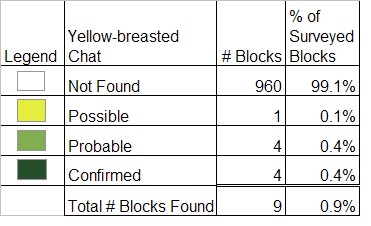Breeding Bird Atlases (BBA)
Find a Bird - BBA1
Breeding Bird Atlas 1 Species Accounts
Yellow-breasted Chat
Icteria virens
Egg Dates
May 18 to June 18
Number of Broods
one

A basically southern species, the Yellow-breasted Chat is at the northern limit of its range in Massachusetts. Never numerous, and limited in its distribution by habitat, the chat historically has been found regularly only in the eastern lowlands and western river valleys. Its numbers have varied dramatically over the years. Forbush’s map shows summer records from all counties except Nantucket, with a concentration from southern Essex County through the Boston area to Norfolk County. At that time, there were even some records from the Worcester County uplands. During the Atlas period, the chat was absent as a breeder from most of the state. The southeastern coast seems to be the only area where it continues to nest with any regularity. Post-Atlas records from western Massachusetts include pairs from Northampton, Agawam, and Lenox.
A few males arrive in May with waves of other migrants in various locales, but usually disappear after a day or two of fruitless singing. Residents are on territory by late May or early June. The chat is a secretive, thicket-loving bird, and prefers a dry, mixed transition habitat with tall grasses and weeds alongside briers and grape tangles as well as scattered small trees and bushes. Such habitat occurs here only in transition as pastures and fields revert to forests, and that process on a wide scale has almost ended in Massachusetts.
In its favored tangles, the chat lurks and feeds, sending out his extraordinary song of loud, clear hoots, deep caws, and nasal mews in measured and unending succession, usually two or three similar notes at a time in an unpredictable sequence. They make short, furtive flights and confound the listener when the calls start again from a completely different place. Once the male has attracted a mate and nesting begins, his song quickens and becomes more continuous and fervent, and he rises from the thickets to the top of a bush or nearby tree. If there are other males present, the singer is especially apt to perform his supreme display, mounting into the air to hover with dangling legs as he pours forth his song. Much of the vocalizing continues during the night.
Up to six eggs are laid in a well-hidden, bulky nest of leaves and bark strips lined with small grasses and placed about 3 feet above the ground. Incubation lasts 11 to 13 days, and the young leave the nest after about 10 days. Incubation and brooding are performed by the female, but both the male and female feed the young. Little is known about the nesting of this species in Massachusetts. The Worcester County confirmation in Leicester was of one member of a pair carrying food on June 20 (TC).
The birds disperse shortly after the young are reared. In this species, the young as well as the adults have a complete molt after the nesting period. Some fruit is eaten in summer in addition to insects, but in autumn the birds become dependent on the former food source. Fall migrants are curiously abundant for a species at the northern edge of its range and begin to appear along the coast in mid- to late August, with numbers peaking in mid-September and continuing through October. Some individuals routinely linger into winter. Most do not survive the coldest weather, even on those rare occasions when they frequent suet feeders. Although curious and responsive to luring sounds, the birds could be completely overlooked at this time and perhaps were in years past. Yellow-breasted Chats winter from the southern United States south through Middle America to western Panama.
Map Legend and Data Summary
Atlas 1 data collected from 1975-1979


Note: rare, local, and irregular in dense thickets of overgrown fields in southeastern region and lower Connecticut River valley
Seth Kellogg



